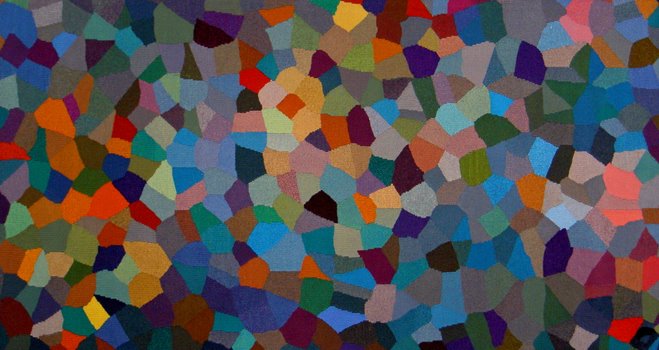Pia Skaarer Nielsen , Nova Scotia, Canada documented her process of creating her shapes for the Fate, Destiny and Self Determination project.
She writes: "I had not woven tapestry for several months, but this project reminded me how much I love to sink into the colours, textures and the story of why I am choosing to weave a piece....time for deep contemplation and the start on another piece on the tapestry loom. "
Pia writes:
" It is strange how something so ‘small’ can take so long to get done, and finished up. Both the pieces were thought long and hard over......Pink Texture - Thinking of the shape and how to execute the actual weaving was not too much of a stretch for my vivid imagination. Then however.....I decided that I needed to do an experiment......I had dyed some of my lamb fleece earlier in the fall and so sat down to spin it one fine evening when I thought I had better get a move on. The idea was that I would spin a two ply, a three ply and a four ply and that the difference in one strand would make a clear visible difference in the woven piece. I wove and felt my brow wrinkle, probably there was more texture to my wrinkled brow than there was to the finished very pink but not very textured piece. In conclusion to this first experiment I have to say, that when I choose to do another piece where the liveliness and the interest is to be in the changing textures I would do not a 2, 3 and 4 ply of the same heaviness single but perhaps a 2, 3 and 4 ply of increasingly heaver singles..... I finished this piece with knots at the edges and then sewing in the ends for final security.........it was a ‘flat’ kind of learning experience, but fun!"
" It is strange how something so ‘small’ can take so long to get done, and finished up. Both the pieces were thought long and hard over......Pink Texture - Thinking of the shape and how to execute the actual weaving was not too much of a stretch for my vivid imagination. Then however.....I decided that I needed to do an experiment......I had dyed some of my lamb fleece earlier in the fall and so sat down to spin it one fine evening when I thought I had better get a move on. The idea was that I would spin a two ply, a three ply and a four ply and that the difference in one strand would make a clear visible difference in the woven piece. I wove and felt my brow wrinkle, probably there was more texture to my wrinkled brow than there was to the finished very pink but not very textured piece. In conclusion to this first experiment I have to say, that when I choose to do another piece where the liveliness and the interest is to be in the changing textures I would do not a 2, 3 and 4 ply of the same heaviness single but perhaps a 2, 3 and 4 ply of increasingly heaver singles..... I finished this piece with knots at the edges and then sewing in the ends for final security.........it was a ‘flat’ kind of learning experience, but fun!"
Yellow piece - (below) knowing how ‘flat’ the pink piece had gone I decided to try some other yarns, having some of the same thoughts. The first yarn chosen was designed for an earlier tapestry project - I had plied and dyed some hardspun warp wool singles - In that project I had been aiming for a variegated yarn so the finished weaving surface would have colour movement that happened according to where the yarn wanted to go, not the colour of the butterflies I might choose to work with. The next yarn that I picked was a very heavy wool single, I think dyed with onion skins. I purchased looms and yarn from the family estate of tapestry weavers Gisela and Hans Dörfer in Little Narrows, Cape Breton some years back and still have some of their handspun yarns. I enjoy using them in various tapestry and weaving projects. The final middle part was spun from a variegated commercial blue faced leicester roving, the colours fit perfectly and the piece that I ended up weaving with just happened to have this greenish hue, although on close inspection it also has a good colour play and changes in it. I chose to finish up the edges with the ‘braiding’ technique I like to finish my bigger tapestries with and was surprised to see how well it worked - it ended up being quite inconspicuous since I had used the same yarn for warp and weft.....which I had noticed on some of the photos from participants who had already sent in their submissions. In conclusion I am excited about the feeling of depth which happened in this piece, due to the play between the textures of the yarns and the colours.
Sheila Brown, UK.
Similarly, Sheila also spun her own yarn. She writes that she is a textile artist and doesn't usually work in the tapestry technique. One could never tell based on how beautifully she has woven this little gem.
OTHER TAPESTRY INSPIRATION, RESOURCES, AND EXHIBITIONS
Weavings by Audrey Moore: Ladies. https://www.storehouse.co/stories/l5fr-ladies
Juana Sleizer is having a fibre/tapestry exhibition.Mimico Centennial Library: 47 Station Road, Toronto, M8V 2R1 Closest major intersection Lake Shore Blvd. West and Royal York Rd. Located on Southeast corner of Stanley Street and Station Road. The exhibit takes place at the Mezzanine and there is no elevator http://www.torontopubliclibrary.ca/detail.jsp?Entt=RDMEVT144191&R=EVT144191
Tapestry Tour in the UK with Cresside Collette
Cranbrook loom for sale (for the serious tapestry weaver)http://denver.craigslist.org/art/4340473916.html


























